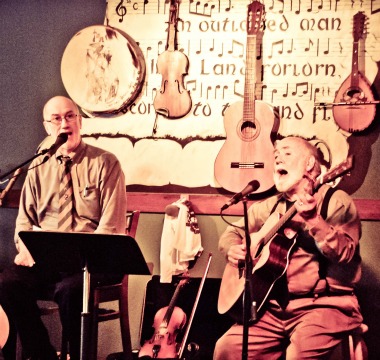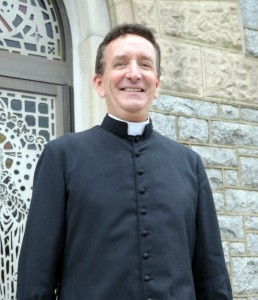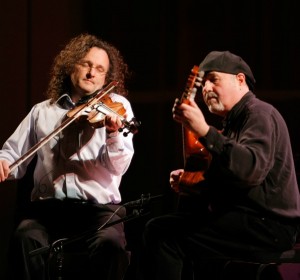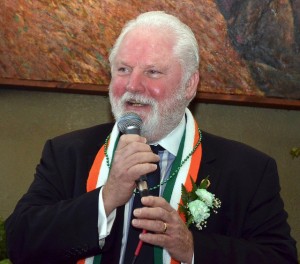
Gerry Timlin and Tom Kane at the Shanachie on St. Patrick's Day
Marybeth, Karen and Sean O’Connor were doing what they do every St. Patrick’s Day, celebrating Sean’s birthday at The Shanachie Irish Pub and Restaurant in Ambler.
On stage in the dining room, the pub’s co-owner, Gerry Timlin and his musical partner of more than 30 years, Tom Kane, sang the Stan Roger’s folk favorite “The Mary Ellen Carter,” about the efforts to raise a sunken ship. Standing in the sea of revelers in bar, the O’Connors and their friends sang along, fist-pumping through its rousing chorus:
“Rise again, rise again—though your heart it be broken
Or life about to end.
No matter what you’ve lost, be it a home, a love, a friend,
Like the Mary Ellen Carter, rise again.”
Quietly, Timlin’s Shanachie partner, Ed Egan, slipped out of the crowd. When he reappeared later, he confessed that the song had choked him up. “I had to go upstairs and gather myself,” said Egan, an attorney, who, with Timlin, opened the popular Ambler spot about eight years ago.
This was the last St. Patrick’s Day celebration at the Shanachie, which will close its doors for good on Saturday, March 31, and Egan wasn’t the only one who was choked up.
“I’m very sad,” said Linda McGarry of North Wales, who had to nearly shout to be heard over the din of the crowd. “I love Gerry and I love it here. I’m going to miss it so much.”
“We’re devastated,” said another woman, there with her whole family. “This is where we come for birthdays, all our celebrations. It makes me sad.”
All night, Timlin said in a phone conversation later in the week, “I just kept trucking. It was tough, very emotional, so I just kept working and kept myself busy but is was, at the end of the night, tough to say the least. This was my dream. It was always something I wanted to do.”
A native of County Tyrone, Northern Ireland, Timlin came to the US in 1972 as a skilled carpenter, but started working at bars and restaurants—McGurk’s in Wyndmoor, Toner’s in Fort Washington, Brittingham’s in Lafayette Hill—which suited his gregarious personality better than creating perfect mitered corners.
He’s been singing with Tom Kane almost since he arrived in the US from the tiny town of Coalisland. He came to know Ed Egan when the two met after a performance in Washington, DC, where Egan then worked. They shared the vision of an Irish pub where they would serve both traditional and new Irish cuisine and there would be music, Irish folk and traditional music, the kind Timlin grew up with and they both loved.
“I’d always wanted to be in the restaurant business as an owner,” said Timlin. “I had no visions of grandeur, that this was going to make me rich. I liked the concept of the Irish pub and wanted to do it better than others and to some degree I think we did.”
He said he thought restaurant owners should always have a physical presence, so either he or Egan were almost always there, not waiting on tables but strolling by, talking to patrons. And if he knew you even a little bit, there was always a chance that Gerry Timlin would pull up a seat and regale you with stories of Coalisland, his family, or life on the road as a musician or on the links as a golfer. Or that Ed Egan might get up a sing a song.
The Shanachie has always had a well-attended Tuesday night session, which occasionally draws well-known Irish musicians (like Angelina Carberry and Martin Quinn who came in the week they were playing at the Irish Center). There’s music every weekend, frequent fundraisers, and the occasional concert. “We had Mick Moloney, Robbie O’Connell, Jimmy Crowley, Finbar Furey,” said Timlin, ticking off some of the other big names—people he knows from his years in the music business—who played on the pub’s stage.
And, of course, Timlin and Kane. After the appearance of The John Byrne Band on March 24, it’s Timlin and Kane the next night and till the end. “Paraic Keane is joining us on the 30th,” says Timlin. Keane is a Dublin-born fiddler, now living in Philadelphia. Timlin and Kane will close the Shanachie on March 31.
After that a new restaurant will be moving in. Timlin won’t reveal the name. “We were able to make the announcement ourselves when we moved in, so they should have the same opportunity,” he says.
He also won’t say why the Shanachie is closing, though he admitted that it’s been stressful for some time. “It’s bittersweet. I’m going to miss it terribly. But there are some things I’m not going to miss,” he said.
Both Egan and Timlin have kept their hands in their other chosen occupations. Timlin still travels around the country performing. Egan practices law with Timoney Knox in Fort Washington and is director of the pre-law program at his alma mater, Mount St. Mary’s University in Emmitsburg, MD.
Timlin says he’s already received a few “very nice offers” that he acknowledges have surprised him. “I think, why me? I’m incredibly humbled by it and I’m not the easiest person in the world to humble,” he says with a laugh.
Wherever he lands, though, he’ll find familiar faces. The O’Connor family haven’t even thought about where they’ll spend next St. Patrick’s Day and Sean O’Connor’s birthday. But, says Marybeth O’Connor, “My parents have been following Timlin and Kane for 30 years, following them wherever they played. We’ll find Gerry wherever he goes.”
View our photo essay.








